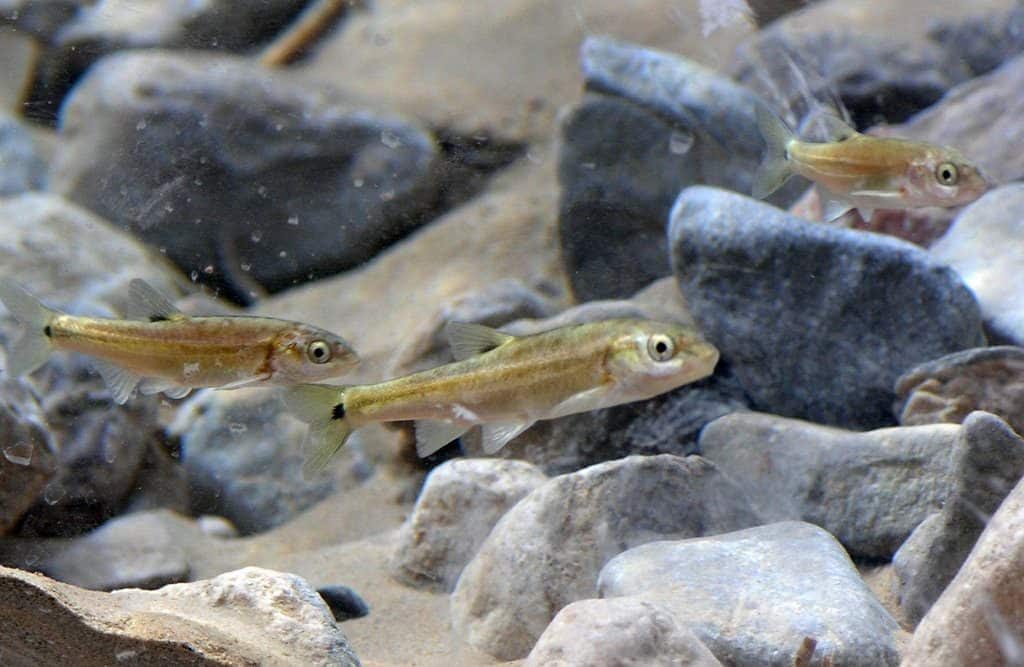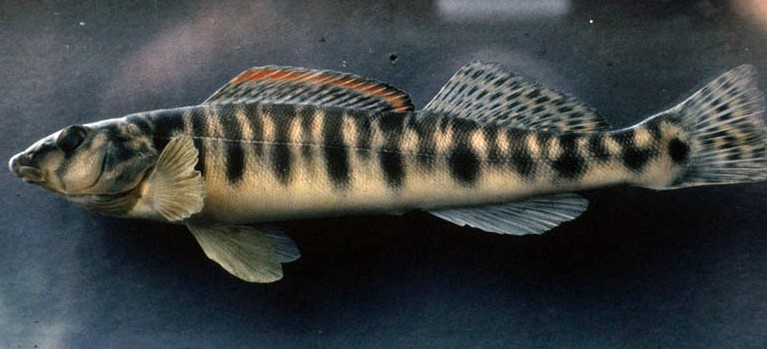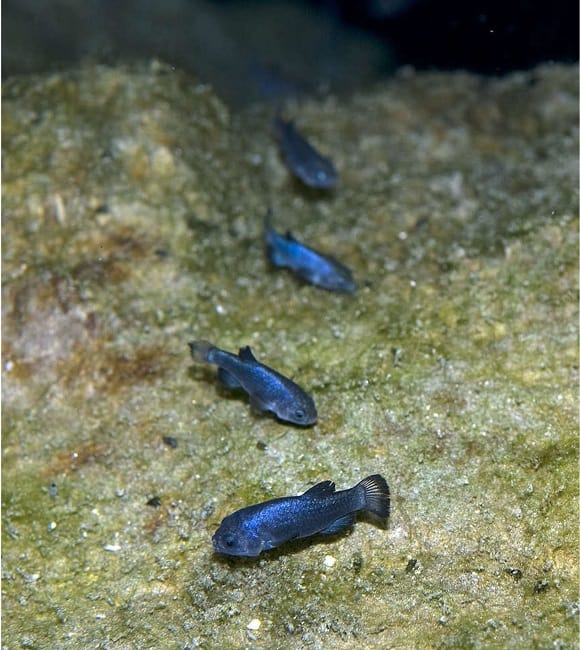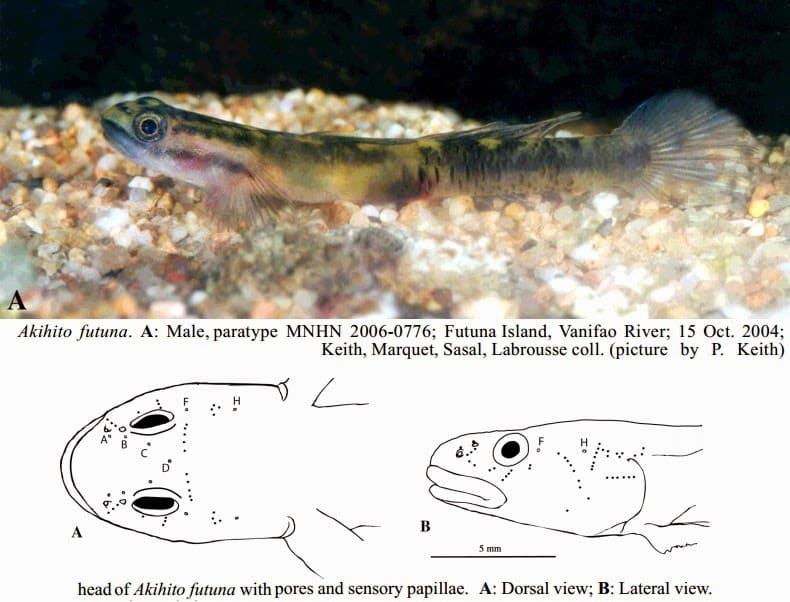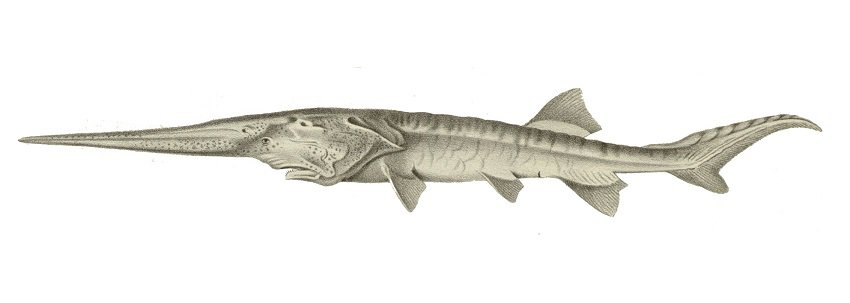Freshwater fish are widely cited as the most endangered group of animals in the world. Habit loss, water pollution, and overfishing are the biggest threats to wild freshwater fish. The freshwater fishes on this list are rare because they’re critically endangered and some may already be extinct in the wild.
Although conservation efforts have been ongoing, often times the habitats that these freshwater fishes live in are not being properly protected. If humans aren’t more careful, several of the freshwater fishes on this list may disappear completely.
- Moapa Dace
- Conasauga Logperch
- Devils Hole Pupfish
- Futuna’s Emperor
- Diamond Darter
- Alabama Sturgeon
- Damba Mipentina
- Chinese Paddlefish
Range (Location): Muddy River (formerly the Moapa River), Nevada, USA
Size of Range: 16 km (10 mi)
Scientific Name: Moapa coriacea
Conservation Status: Critically Endangered

photo source: Flickr via U.S. Fish and Wildlife Service Pacific Southwest Region
When the Moapa Dace was first discovered in 1938, this now rare fish was considered quite common. Moapa Dace numbers started to take a hit in 1963 when the shortfin molly (Poecilia mexicana) was introduced into its habitat. A few years later, the Moapa Dace was classified as endangered and this small freshwater fish has never really recovered.
The most recent surveys from about a decade ago estimate that there are between 450 – 460 Moapa Dace left. The Moapa Dace still faces the same threats as it did in the past, which includes the destruction or alteration of its habitat. Although a recovery plan for the Moapa Dace was propsed all the way back in 1983, it has not been adequately implemented. The Center for Biological Diversity is one of the groups working to protect the Moapa Dace and they have continuously fought to stop further water developments in and near the Moapa Dace’s habitat.
Range (Location): Conasauga River in Georgia and Tennessee, USA
Size of Range: 45 km (27 mile)
Scientific Name: Percina jenkinsi
Conservation Status: Critically Endangered (CR)

photo source: Wikimedia Commons via Jerry A. Payne, USDA Agricultural Research Service
The Conasauga Logperch is a species of darter fish native to North America. Specifically, the Conasauga Logperch can only be found in about an 27 mile (45 km) stretch of the Conasauga River in Georgia and Tennessee. According to the IUCN Red List there may be fewer than 200 individual Conasauga Logperch fish remaining in the wild.
There are ongoing conservation efforts to keep the Conasauga Logperch alive in the wild. In 2012, conservationists released 382 tagged Conasauga Logperch back into the wild and many were still alive during subsequent surveys.
Range (Location): Devils Hole, Ash Meadows, Death Valley National Park, Nevada, USA
Size of Range: Unspecified small cave lake (smallest geographic range on any vertebrate)
Scientific Name: Cyprinodon diabolis
Conservation Status: Critically Endangered (CR)

photo source: Wikimedia Commons via Olin Feuerbacher of the U.S. Fish and Wildlife Service
Despite its ominous sounding name, the Devils Hole Pupfish is actually a cute little blue fish found in a cave lake at the Devils Hole in Death Valley National Park, Nevada. Since the Devils Hole Pupfish was first monitored, it has never had a population larger than 553 individuals. In recent years, the population of Devils Hole Pupfish has declined and in 2013, this rare fish hit its lowest count at only 35 fish.
There was some good news recently, in October 2018, when scientists reported that they had counted about 187 Devils Hole Pupfish during their most recent survey. This is the highest number of Devils Hole Pupfish recorded since 2003. The scientists also said that the current Devils Hole Pupfish population looks healthy and a majority are juveniles and young adults.
Range (Location): Island of Futuna, Wallis and Futuna
Size of Range: 5 km (3.1 mi)
Scientific Name: Akihito futuna
Conservation Status: Critically Endangered (CR)

photo source: novataxa.blogspot.com
The Futuna’s Emperor is a fairly recently discovered freshwater goby that has only been found in one river on the island of Futuna in the South Pacific. It is believed that the Futuna’s Emperor may have been more abundant in the past and lived in the other five streams on the island.
The current total population of Futuna’s Emperor fish is unknown. During the last survey in 2011, researchers only identified about 20 individuals. The major threat to the Futuna’s Emperor is habitat loss as the surrounding lands are being cleared for taro farming and construction. Little is known about the Futuna’s Emperor, but researchers believe that the freshwater goby prefers water temperatures around 20ºC (68ºF). Farming practices have increased the temperature of the waters that the Futuna’s Emperor lives in.
Range (Location): Elk River, West Virginia, USA
Size of Range: 22 mi (13.67 km)
Scientific Name: Crystallaria cincotta
Conservation Status: Critically Endangered (CR)

photo source: National Wildlife Federation
The Diamond Darter is yet another rare freshwater fish on this list, whose current population numbers are unknown. This little freshwater fish that is only found in the Elk River of West Virginia is so rare that it was only formally described in 2008, even though specimens were first collected in 1980. Despite many efforts to find the existing population of Diamond Darters in the wild, only about 19 specimens have been collected over the past 30 years.
In 2013, the U.S. Fish and Wildlife Service announced that the Diamond Darter would now be protected under the Endangered Species Act. The Diamond Darter’s home, the Elk River, is continuously threatened by coal mining, oil and gas development, siltation from these and other sources, inadequate sewage and wastewater treatment. Habit loss and water quality degradation from these activities are the biggest threats to the Diamond Darter’s survival.
Range (Location): lower Alabama River, Alabama, USA
Size of Range: about 216 km (134.22 mi)
Scientific Name: Scaphirhynchus suttkusi
Conservation Status: Critically Endangered (CR)

photo source: Wikimedia Commons via Patrick O’Niel
Overall, sturgeon are some of the most critically endangered freshwater fish in the world, and the Alabama Sturgeon is one of the rarest of all sturgeon species. The Alabama Sturgeon was declared critically endangered in early 2000 by the U.S. Fish and Wildlife Service because of its low population numbers and inability to naturally increase its numbers. Since 1997, scientists have only captured six Alabama Sturgeon specimens and there have only been three reported sightings in the past decade.
For many years, scientists believed that the Alabama Sturgeon had gone extinct. However, in 2016, scientists determined that the Alabama Sturgeon was still alive by finding its DNA in various locations of the Alabama River. The new find brings renewed hope to the scientists, who want to know learn more about the Alabama Sturgeon so they can help their population recover.
Range (Location): Betsiboka and Mahajamba river basins in northwestern Madagascar
Size of Range: 100 km² (38.6 mi²)
Scientific Name: Paretroplus maculatus
Conservation Status: Critically Endangered (CR)

photo source: IUCN Red List
The Damba Mipentina is a critically endangered freshwater fish that has not been seen in its known habitats for many years. Previous surveys of the Damba Mipentina showed that the population was sharply declining and the current status of the population is unknown. With no sightings or evidence that the Damba Mipentina still even exists in the wild, it is one of the rarest freshwater fish in the world.
The Damba Mipentina’s demise the in wild is attributed to overfishing, habitat loss, and the presence of non-native invasive species (mostly the Asian snakehead) in its home waters. While the number of wild Damba Mipentinas is a mystery and cause for alarm, a few fish enthusiasts are raising Damba Mipentina in captivity.
Range (Location): Yangtze River, China
Size of Range: Unspecified
Scientific Name: Psephurus gladius
Conservation Status: Critically Endangered (Possibly Extinct)

photo source: Wikimedia Commons via Muséum d’histoire Naturelle
The current status of the Chinese Paddlefish in the wild is completely unknown and that last time that anyone has seen an adult Chinese Paddlefish was in 2007. For right now, the IUCN Red List still classifies the Chinese Paddlefish as critically endangered, but does note that it might actually be extinct in the wild. Since there is no recent evidence that the Chinese Paddlefish even still exists and there are none in captivity, the Chinese Paddlefish can be considered the rarest freshwater fish in the world.
According to a report by National Geographic in 2009, no juvenile Chinese Paddlefish have been seen since 1995. This suggests that the Chinese Paddlefish may not be reproducing. There have been numerous attempts to establish a captive breeding program with the few Chinese Paddlefish that have been captured in the past. However, the last known captive breeding pair of Chinese Paddlefish died in 2004 and the female was pregnant.

